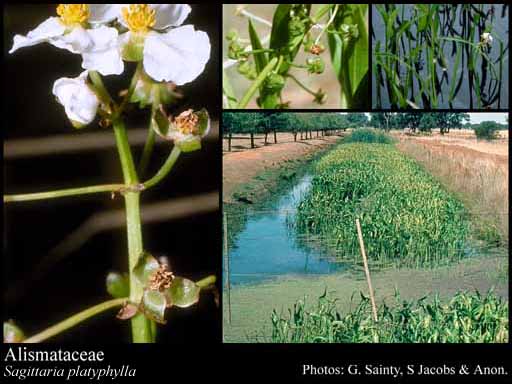- Reference
- Tabl.Regn.Vég. 2:157 (1799)
- Name Status
- Current

Scientific Description
Common name. Water-plantain Family.
Habit and leaf form. Herbs; laticiferous. Annual (rarely), or perennial; plants with a basal concentration of leaves; rhizomatous. Hydrophytic, or helophytic; rooted. Leaves submerged and emergent. Heterophyllous (often), or not heterophyllous. Leaves alternate; petiolate, or sessile; sheathing; simple. Leaf blades pinnately veined (or parallel-pinnate), or palmately veined, or parallel-veined; cross-venulate, or without cross-venules. Axillary scales present. Stem anatomy. Secondary thickening absent.
Reproductive type, pollination. Fertile flowers hermaphrodite, or functionally male and functionally female, or functionally male, or functionally female. Unisexual flowers present, or absent. Plants hermaphrodite, or monoecious, or dioecious (rarely), or polygamomonoecious. Floral nectaries present. Nectar secretion from the perianth, or from the gynoecium, or from the androecium (from the tepal or stamen bases in Echinodorus, but usually from the bases of the sides of the carpels).
Inflorescence and flower features. Flowers aggregated in ‘inflorescences’ (usually), or solitary. The terminal inflorescence unit cymose, or racemose. Inflorescences scapiflorous; paniculate, often complex with verticils of branches, sometimes umbellate through reduction of the whorls to one; with involucral bracts, or without involucral bracts. Flowers bracteate; regular; 3 merous; cyclic; tetracyclic to polycyclic. Perigone tube absent. Perianth with distinct calyx and corolla (ostensibly), or of ‘tepals’; 6; 2 -whorled; isomerous; free; sepaloid and petaloid; spotted; different in the two whorls; white, or red, or pink (inner), or green (outer). Calyx if the outer perianth be so interpreted, 3; 1 -whorled; polysepalous. Corolla if the inner perianth be so interpreted, 3; polypetalous; white, or red, or pink. Fertile stamens present, or absent (when female). Androecium (3–)6 (in one cycle), or 18–100 (i.e. to many). Androecial members branched (usually, e.g. Alisma having three stamen pairs, while forms with numerous stamens have them seemingly spiralled, but actually reflecting whorls of trunk bundles), or unbranched (occasionally). Androecial sequence determinable, or not determinable. Androecial members when in more than one whorl, maturing centripetally; free of the perianth; free of one another (but when 6, in pairs next to the petals); 1–20 -whorled (i.e., to ‘many’ whorls). Androecium exclusively of fertile stamens. Stamens 3, or 6, or 18–100 (i.e. to ‘many’); reduced in number relative to the adjacent perianth, or isomerous with the perianth to polystemonous; alterniperianthial. Anthers dehiscing via longitudinal slits; extrorse. Fertile gynoecium present, or absent (male flowers). Gynoecium 3 carpelled, or 6–100 carpelled (or more — i.e. to many); apocarpous; eu-apocarpous; superior. Carpel apically stigmatic, or with a lateral style, or with a gynobasic style; 1 ovuled, or 2 ovuled (rarely more). Placentation basal. Stigmas dry type; papillate; Group II type. Ovules ascending; anatropous, or amphitropous.
Fruit and seed features. Fruit non-fleshy; an aggregate. The fruiting carpels not coalescing. The fruiting carpel dehiscent, or indehiscent; a follicle, or an achene. Seeds non-endospermic; with starch. Cotyledons 1. Embryo achlorophyllous (3/5); strongly curved (horseshoe-shaped). Seedling. Hypocotyl internode present. Mesocotyl absent. Seedling collar not conspicuous. Cotyledon hyperphyll elongated; assimilatory; more or less circular in t.s. Coleoptile absent. Seedling macropodous. Seedling cataphylls absent. First leaf dorsiventral. Primary root ephemeral.
Physiology, biochemistry. Photosynthetic pathway: C3.
Geography, cytology, number of species. World distribution: cosmopolitan. X = (5-)7–11(-13). 90 species.
Economic uses, etc. Includes important aquarium and pond ornamentals, and some Sagittaria species have edible rhizomes.